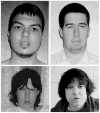22q11 deletion syndrome in adults with schizophrenia
- PMID: 9674980
- PMCID: PMC3173497
22q11 deletion syndrome in adults with schizophrenia
Abstract
Genetic syndromes associated with deletions at chromosome 22q11 generally have been diagnosed during childhood based on a constellation of physical features. To investigate a reported association of velocardiofacial syndrome with psychotic disorders in adults, we assessed subjects with DSM-IV schizophrenia or schizoaffective disorder who were referred with two or more syndromal features (palatal, cardiac, facial, or other congenital anomalies, and/or learning difficulties). We report on 10 subjects (5 men and 5 women), mean age 27.2 (SD 6.0) years, who were found to have a 22q11 deletion at locus D22S75 using fluorescence in-situ hybridization (FISH). The mean age at onset of psychosis was 19.6 (SD 4.6) years. Symptoms and course of the psychotic illnesses were unremarkable, but additional signs such as temper outbursts were common. These adult subjects had significantly fewer major palatal (P = .0001) and conotruncal cardiac (P = .05) anomalies but the same high rate of learning difficulties as a sample with deletion 22q11 ascertained through a pediatric clinic [Lindsay et al. (1995): Am J Med Genet 57:514-522]. Minor congenital features and rate of transmitted cases were similar to those previously reported. These results replicate the association of a 22q11 deletion syndrome with schizophrenia and confirm the importance of ascertainment in influencing the phenotype found. The findings support a developmental gene in the 22q11 deletion region causing a complex phenotype which may include significant behavioral components that emerge over time. We support using the term "22q11 deletion syndrome (22DS)," which would encompass physical and psychiatric features, and could also be applied to describe a genetic subtype of schizophrenia.
Figures
References
-
- Amati F, Mari A, Digilio MC, Mingarelli R, Marino B, Giannotti A, Novelli G, Dallapiccola B. 22q11 deletions in isolated and syndromic patients with tetralogy of Fallot. Hum Genet. 1995;95:479–482. - PubMed
-
- American Psychiatric Association. Diagnostic and Statistical Manual of Mental Disorders. 4. Washington, DC: American Psychiatric Association; 1994. pp. 273–296.
-
- Budarf ML, Konkle BA, Ludlow LB, Michaud D, Li M, Yamashiro DJ, McDonald-McGinn D, Zackai EH, Driscoll DA. Identification of a patient with Bernard-Soulier syndrome and a deletion in the Di-George/velo-cardio-facial chromosomal region in 22q11.2. Hum Mol Genet. 1995;4:763–766. - PubMed
Publication types
MeSH terms
Grants and funding
LinkOut - more resources
Full Text Sources
Medical

